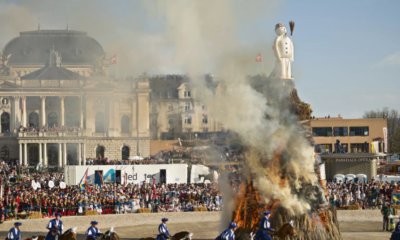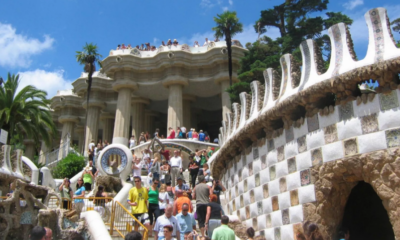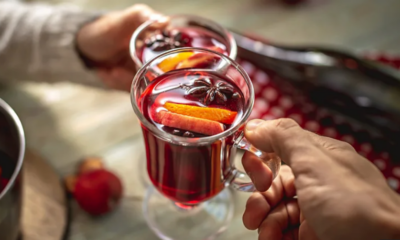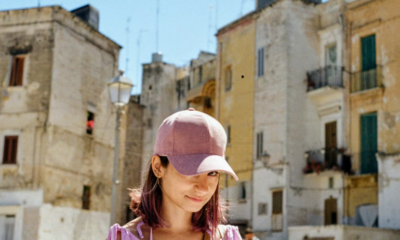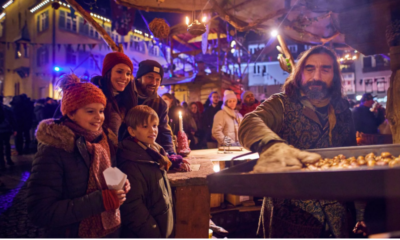Northern Lights Set for Unprecedented Brilliance in 2025
The northern lights are expected to shine brighter and appear more frequently in 2025 than they have in over a decade, thanks to a peak in solar activity. This spectacular celestial phenomenon has already dazzled viewers across Europe in late 2024, with auroras visible much farther south than usual.
The vivid display, also known as the aurora borealis, occurs when charged particles from the sun—called the solar wind—interact with Earth’s atmosphere. Typically visible only near the Arctic Circle, the lights’ mesmerizing colors, ranging from green to magenta, have recently graced skies as far south as England, Slovenia, and even parts of Italy and Greece.
Why the Northern Lights Are More Active
The heightened activity is due to the sun nearing the peak of its 11-year solar cycle, during which its magnetic field flips completely. This peak, occurring between 2024 and 2025, has led to a surge in sunspots, a key indicator of solar activity.
In some cases, Coronal Mass Ejections (CMEs)—large expulsions of plasma and magnetic fields from the sun’s atmosphere—cause the aurora’s typical Arctic zone to expand. This phenomenon allows the lights to appear at lower latitudes, offering rare opportunities for stargazers across Europe.
In November 2023, an unusually strong aurora spectacle lit up skies from southern England to Central Macedonia in Greece. Photographers captured breathtaking images of magenta and fuchsia hues, with the specific colors depending on the type of gas molecules and their altitude in the atmosphere.
Best Locations to Witness the Northern Lights in 2025
For those eager to experience this natural wonder, 2025 is an ideal year to plan an aurora-chasing trip. Traditional hotspots like Finland’s Lapland, Tromsø in Norway, Abisko in Sweden, and Iceland’s Thingvellir National Park remain top destinations. These locations offer clear skies, minimal light pollution, and proximity to other natural marvels, such as geysers and hot springs.
Jokkmokk in Sweden, recommended by travel experts, combines aurora sightings with insights into Sami culture and traditions. For those unable to venture far, the intensified solar activity means that northern lights may also be visible in countries like the UK, Germany, and Italy. International Dark Sky Parks, which preserve night skies free from artificial light, are excellent local options for aurora viewing.
A Unique Opportunity
With the sun entering a particularly active phase, the northern lights are poised to be more brilliant and widespread than they’ve been in years. Experts suggest aiming for the March and October equinoxes, when geomagnetic activity tends to peak. Whether from the Arctic Circle or closer to home, 2025 promises unforgettable opportunities to witness the ethereal beauty of the aurora borealis.
Travel
Discover Europe’s Most Unique Folk Festivals: Tradition and Fire
Europe is home to some of the world’s most fascinating folk festivals, steeped in centuries-old traditions and customs. These festivals, often overlooked in favor of more mainstream celebrations, offer an immersive experience into local culture, folklore, and community spirit. From ancient pagan rituals to modernized folk practices, these events provide a glimpse into Europe’s rich cultural heritage.
Surva: Bulgaria’s Ancient Festival to Banish Evil
In the heart of Bulgaria, the Surva Festival, held in early January, celebrates a tradition that dates back thousands of years. The festival, particularly vibrant in the town of Pernik, is marked by the ‘kukeri’—dancers dressed in intimidating animal masks, fur suits, and bells, who parade through the streets to drive away evil spirits and usher in good health and fortune for the year. The festival, recognized by UNESCO, includes torch-lit processions, singing, and dancing. The International Festival of the Masked Games, held during the last weekend of January in Pernik, further showcases this centuries-old ritual through grand parades and competitions.
San Antón Festival: Fire and Blessings in Andalusia
From January 16 to 18, Andalusia’s villages come alive with the San Antón Festival, celebrating Saint Anthony, the patron saint of animals. Rooted in 800 years of tradition, the festival features bonfires, folk dances, and a quirky ritual of blessing pets, from dogs to hamsters. The festival’s origins trace back to the 13th century when farmers believed that burning olive branches and baskets could protect their animals and crops from pests. Today, locals gather to celebrate with music, food, and dancing around the fires, while pet owners have their animals blessed in local churches. The festival, which spans multiple Andalusian towns, includes a unique 10-kilometer night run in Jaén.
Up Helly Aa: Scotland’s Viking Fire Festival
One of Europe’s youngest and most electrifying festivals, Up Helly Aa, takes place on the last Tuesday of January in Lerwick on Scotland’s Shetland Islands. Celebrating the island’s Viking heritage, the festival features a torch-lit procession, where participants dressed in Viking costumes march through the streets before setting fire to a replica Viking longship. The festival, which began in the 18th century and formalized in 1870, now includes parades, feasts, and even the participation of women and girls in the traditionally male-dominated torchlit procession.
Dragobete: Romania’s Day of Love
For a more authentic celebration of love, Romania’s Dragobete festival, held on February 24, offers a unique alternative to Valentine’s Day. Rooted in ancient Romanian folklore, Dragobete is the son of Baba Dochia and the Dacian god of love. During the festival, young people gather to pick spring flowers, with wild strawberries considered especially lucky. In a charming tradition, boys chase girls who run back to the village, and if a connection is made, they kiss to signify their love. Engaged couples often emerge from the festival, but singles can also enjoy cultural events and performances across cities like Bucharest.
Sechseläuten: Zurich’s Fiery Farewell to Winter
Europe’s winter festivals often center around fire, and Zurich’s Sechseläuten on the third Monday of April is a spectacular example. The festival marks the unofficial end of winter, with guilds parading through the city, culminating in the burning of the Böögg, a snowman-like figure stuffed with explosives. The tradition holds that the faster the fire reaches the Böögg’s head and causes it to explode, the better the coming summer will be. This fiery ritual, which draws crowds from all over, symbolizes the city’s hope for warmth and good fortune in the months to come.
From ancient rituals to modern celebrations, these festivals offer a deep dive into Europe’s diverse traditions and the timeless spirit of community.
Travel
Barcelona Pushes Back on Overtourism with New Measures for 2025
Barcelona, Spain’s most visited city, is taking decisive action to tackle overtourism, which has caused mounting tensions between locals and tourists. With over 15 million annual visitors drawn by its iconic architecture, vibrant culture, and seaside location, the city has introduced a series of measures to prioritize residents’ quality of life and promote sustainable tourism.
Crackdown on Short-Term Rentals
In June, Barcelona’s City Council announced a bold plan to phase out tourist flat licenses by 2028, aiming to alleviate the city’s housing crisis. Although no new licenses have been issued since 2014, the nearly 10,000 existing units have kept rent prices high for locals.
“We want to guarantee the right to live in Barcelona,” said Mayor Jaume Collboni, emphasizing the need for housing reform.
However, the tourism industry has pushed back. The Barcelona Association of Tourist Apartments warned that restricting licenses could drive up illegal rentals and hurt the city’s tourism-dependent economy. Legal challenges have also emerged, with the European Holiday Home Association filing a complaint with the European Commission, arguing that the plan violates service provision laws.
Protests and Rising Tensions
Protests against overtourism reached a boiling point in July, with thousands of locals chanting “tourists go home” and symbolically shutting down hotels and restaurants. Activists, like Martí Cusó of the Association of Neighbours of the Gothic Quarter, called for a shift toward an economic model less reliant on mass tourism.
In November, further demonstrations against high rents highlighted overtourism as a contributing factor, reflecting deep frustration among residents.
Tourist Tax and Transportation Measures
Barcelona has also increased its tourist tax, which funds infrastructure, cleaning, and security. By October, the levy rose to €7.50 per night for guests in luxury accommodations, marking a push for “quality tourism.”
Transportation changes were also implemented. The city council removed the overcrowded Route 116 bus from Google Maps to prioritize local access and announced plans to quadruple parking fees for tourist buses around landmarks like the Sagrada Família.
Looking Ahead to 2025
Despite the challenges, Barcelona’s Tourism Consortium remains optimistic. A spokesperson assured that the city remains welcoming and sustainable, emphasizing collaboration between residents and visitors.
While new regulations, such as doubling ticket prices for Park Güell, are being considered, officials believe a balance can be struck. Barcelona aims to foster responsible tourism by encouraging cultural experiences, sustainable transport, and respect for public spaces.
With its blend of innovation and tradition, Barcelona is determined to redefine its tourism model, ensuring a harmonious coexistence between locals and visitors.
Travel
Vin Chaud: A French Holiday Tradition That Warms Hearts and Homes
-

 Travel9 months ago
Travel9 months agoEmbracing Solo Travel to Unlock Opportunities for Adventure and Growth
-

 Politics9 months ago
Politics9 months agoSix Best Things Done by Donald Trump as President
-

 Education9 months ago
Education9 months agoExlplore the Top Universities in the United States for Computer Science Education?
-

 Technology9 months ago
Technology9 months agoRevolutionizing Healthcare Training with Latest Technologies
-

 Health9 months ago
Health9 months agoRise of Liposuction: A Minimally Invasive Solution for Body Contouring
-

 Business9 months ago
Business9 months agoThriving Startup Hubs: Best Cities in the USA for Entrepreneurship
-

 Travel9 months ago
Travel9 months agoWhere to Move? America’s Top Ten Most Affordable Cities
-

 Health9 months ago
Health9 months agoDigestive Power of taking Mint Tea after Meals

